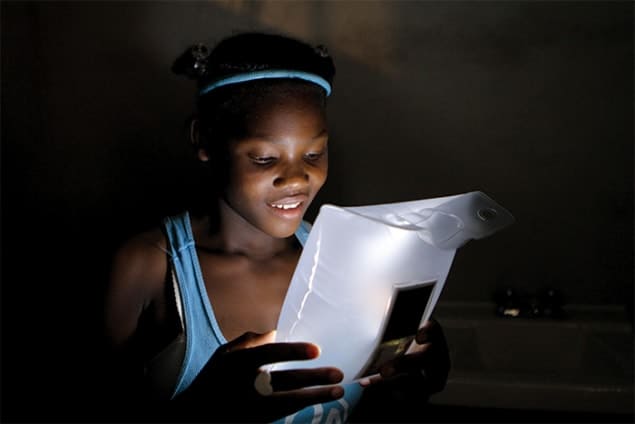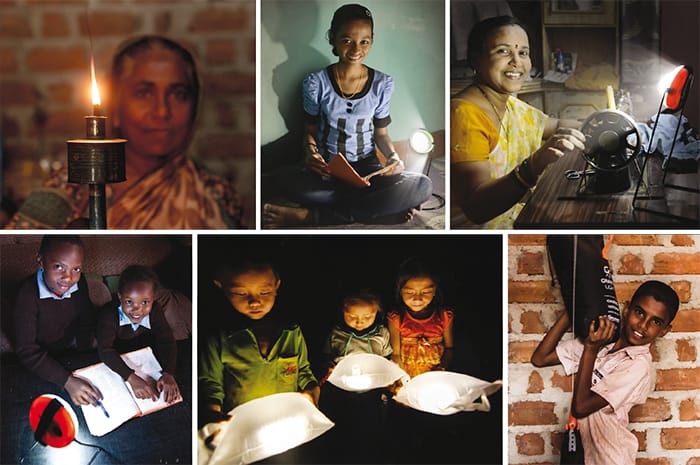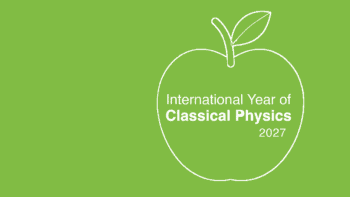More than a billion people across the globe still do not have access to electric lighting. Jon Cartwright talks to those who are turning to light-emitting diodes to supply this most basic feature of modern life

For most of us, life does not stop after a hard day’s work. Some people like to sit down with a good book. Others might want to study or catch up on some household chores. Often the desire is even simpler: a chance to relax and spend time with friends and family.
Such options are always open to about five and a half billion of us. However, for the remaining one and a half billion – some 20% of the world’s population – the choices are rather more limited. These are the people in the developing world who do not have access to on-grid lighting, a feature of modern life that the rest of us take for granted. “If you’re not connected to an electricity grid,” says Beth Taylor, “then at 6 p.m. when the Sun goes down, either life stops or you’re dependent on a smoky, dangerous kerosene lamp.”
Taylor is one of many individuals – others being charity workers, businesspeople, engineers and indeed former physicists – who want to improve access to alternative off-grid lighting. She is chair of the UK National Committee for the International Year of Light, and has been championing the UK effort in Study After Sunset – an initiative that is intended to bring safe off-grid lighting to school-age children in particular. Although the initiative has only just begun, and the number of affected people is huge, Taylor hopes that by the end of 2015 she and her colleagues will have been able to make a difference. “Our aim is to leave a real legacy at the end of the year,” she says.
The dark age
The disadvantages of kerosene lamps compared with electric lamps are almost too numerous to mention. They are inefficient devices that produce a dim glow, directed upwards rather than sideways or downwards where the light would be most useful. They rely on an expensive fuel. And worse still, the toxic black smoke they emit is deadly. According to the World Health Organization, the burning of kerosene contributes to indoor air pollution and respiratory diseases, which kill more than 1.5 million people every year – more than the total child deaths from HIV/AIDS and malaria combined.
It does not stop there. The United Nations Environment Programme estimates that every kerosene lamp generates on average 200 kg of carbon dioxide per year, contributing significantly to global warming. Kerosene itself is often sold in plastic drinks bottles, which children can easily mistake for actual drinks. But the most obvious problem is kerosene’s flammability: a 2012 analysis of Ugandan households by economist Chishio Furukawa at Brown University in the US, found that kerosene lamps were responsible for 70% of fires, many of them fatal.
In 2010 the then US Secretary of State Hillary Clinton launched the Global Alliance for Clean Cookstoves, which aims to reduce deaths from unsafe indoor stoves by partnering companies with charities, and by jointly talking to governments and investors. Taylor hopes that she can instigate a similar alliance in Study After Sunset, which aims to promote the manufacture and marketing of alternative light sources to kerosene lamps. “The Alliance for Clean Cookstoves has made a big impact, and that is the kind of thing I would really like the Year of Light to help with,” she says.
There have been alternatives to kerosene lamps available for a long time, but in recent years one technology has emerged that has blinded the competition: light-emitting diode (LED) lamps. Patrick Walsh began to think about the potential for such lighting in 2006 while he was a physics student at the University of Illinois at Urbana–Champaign, taking time off with the non-profit organization Engineers Without Borders USA to design and build an electricity generator that ran off vegetable oil for a village in India. While he was living in the village, Walsh quickly realized that the locals’ need for electricity mainly stemmed from lighting. “We had brought a couple of LED lamps with us, but the products were just junk,” he says. “At that time, LEDs were sky-rocketing in terms of efficiency and reliability, and it was clear that they were going to be the future, as a replacement for kerosene. The question was, who could make a product to meet that need?”
Walsh thought he could. He carried out a feasibility analysis to see if an LED lamp could be sufficiently more cost effective than a kerosene lamp to make manufacturing it a worthwhile business. He found out that it could be – but that calculation, he now admits, was the easy part. While completing his degree back in the US, Walsh took on extra studies in mechanical and electrical engineering, and then headed to China where he spent two years developing a cheap-yet-effective solar-powered LED lantern. It was only in 2009 that, together with fellow University of Illinois alumni Anish Thakkar and Mayank Sekhsaria, Walsh launched the first “Sun King”.
To anyone who is familiar with modern electrical technology, the Sun King might not seem like much. It looks like a typical portable spotlight that is mounted on a stand made out of bent wire. But, as Walsh explains, it is the details that matter – one of those details being the charging indicator. According to Walsh, many consumers were positioning their prototype lamp’s solar panel in a way that allowed the lamp to charge, but at only half the normal rate – so people would mount the panel on their wall, instead of on their roof. “A normal charging indicator would show that it’s charging, but it wouldn’t show that it’s not charging very quickly,” he adds. “You can solve that with education, but you can also just try to design the product so that it’s obvious to users. So we have on each [Sun King] a charging rate indicator, which influences the way people use the product.”
A new dawn
Walsh’s attention to detail paid off. By 2013 he was selling one million Sun Kings a year, and he estimates that for the company’s last financial year, 2014, that figure will be nearly double. He believes 15 million people worldwide are currently using the lamps, which now come in several variants – the more expensive models even contain a USB socket for charging mobile phones, for instance.
“I was recently in a market in an out-of-the-way city in Kenya,” he recalls. “There were probably 100 stalls, selling food and sundry items – and about half of the stalls were using Sun Kings. It was such a normal part of life that if you asked them about it they were like, ‘Yeah, it’s just what we use for light.’?”

The Sun King is just one of many LED lanterns designed by small companies with the developing world in mind. Most work on the principle of recharging batteries with solar power, although there is at least one interesting exception. In 2013 product designers Martin Riddiford and Jim Reeves in the UK launched GravityLight, an LED lamp that turns gravitational potential energy into electrical energy. Aiming to be as affordable as possible, all you need to do to switch on this lamp is to attach to its hook a filled ballast bag, which gradually lowers, driving a small dynamo to supply electricity to the LEDs. Lifting about 10 kg, which takes only a few seconds, provides 25 minutes of power.
Other lamps have tackled slightly different off-grid lighting problems, such as those that arise in times of natural disasters. That is the focus of LuminAID, an inflatable LED lamp that was invented by product designers Anna Stork and Andrea Sreshta at Columbia University in New York, US, while watching coverage of the aftermath of the 2010 Haiti earthquake. The key strengths of LuminAID are that it is portable and durable. Fifty of the lamps can be folded and packaged into a space that would otherwise contain eight flashlights, and deploying one is as simple as inflating it like a rubber armband. The inflated packaging diffuses the LED’s light, and creates a shockproof, waterproof and buoyant exterior.
One of the turning points for the company came last year when it worked with ShelterBox, a disaster-relief organization based in the UK, to distribute more than 30,000 LuminAID lights to the victims of Typhoon Haiyan, which struck south-east Asia in November 2013. “We heard very positive feedback from the field on this distribution and the impact these lights had,” says Stork. “We have been selling and producing this product for a little over two years and this was the first instance where we had the production capacity and everything up and running to provide lights in a large volume after an emergency.”
Many companies that manufacture off-grid LED lighting have now joined forces under the non-profit Global Off-Grid Lighting Association (GOGLA), which acts as an industry advocate. Koen Peters, the executive director of GOGLA, says that the products currently have a market penetration of 2–5%. “It’s a huge market that we’re only just starting to reach,” he adds.
But it is worth it, he explains – and not just to rid people of the obvious problems of accidental fire and respiratory disease. “Once people have light, they aspire to something beyond it,” he says. “They might spend some of the saved money on a solar electricity generator to charge their phone, rather than go to a village where they will spend half a dollar to charge it. Then they might use the saved money from that to buy a better generator that can charge a radio, or a TV. LED lighting is the first stepping stone to an electric life, to which everyone aspires.”
Illuminating lives
In a sense, says Peters, the challenge for LED lighting is easier than that for clean stoves: whereas in all cultures good light is associated with safety, some cultures tend to cling to their traditional cooking habits of lighting fires indoors. Nonetheless, there are challenges. People need to be more aware of the availability of good LED technology, he says, and of the disadvantages of cheaper competitor products that still beset the marketplace. Moreover, the supply chain is still not as well financed as it could be. “The market is growing 100% a year – but it is being held back by supply, not demand,” he notes.
After all, off-grid lighting is not a purely charitable venture. It is a business and, as it grows, there may well be benefits for everyone. Peters believes that off-grid lighting products could find steadily more customers in developed nations such as the US, which, he says, has less reliable electricity grids than much of Europe. He also believes that developments in off-grid lighting and solar panels could spawn other off-grid technologies, such as flat-screen televisions that can be powered by a solar device via a USB port – particularly once big companies find interest. “Once the Samsungs and Panasonics of this world begin to see the potential in off-grid markets,” he says, “there will be a real benefit for the developed world too. I personally would be interested in a TV that runs off USB.”



